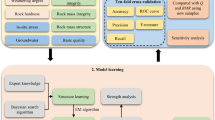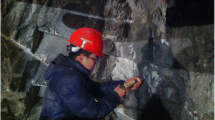Abstract
Engineering design has great importance in the cost and safety of engineering structures. Rock mass rating (RMR) system has become a reliable and widespread pre-design system for its ease of use and variety in engineering applications such as tunnels, foundations, and slopes. In RMR system, six parameters are employed in classifying a rock mass: uniaxial compressive strength of intact rock material (UCS), rock quality designation (RQD), spacing of discontinuities (SD), condition of discontinuities (CD), condition of groundwater (CG), and orientation of discontinuities (OD). The ratings of the first three parameters UCS, RQD, and SD are determined via graphic readings where the last three parameters CD, CG, and OD are estimated by the tables that are composed of interval valued linguistic expressions. Because of these linguistic expresions, the estimated rating values of the last three become fuzzy especially when the related conditions are close to border of any two classes. In such cases, these fuzzy situations could lead up incorrect rock class estimations. In this study, an empirical database based on the linguistic expressions for CD, CG, and OD is developed for training Artificial Neural Network (ANN) classifiers. The results obtained from graphical readings and ANN classifiers are unified in a simulation model (USM). The data obtained from five different tunnels, which were excavated for derivation purpose, are used to evaluate classification results of conventional method and proposed model. Finally, it is noted that more accurate and realistic ratings are reached by means of proposed model.





Similar content being viewed by others
References
Singh B, Goel RK (1999) Rock mass classification, a practical approach in civil engineering. Elsevier Science, Oxford
Aydin A (2004) Fuzzy set approaches to classification of rock masses. Eng Geol 74(3–4):227–245
Bieniawski ZT (1989) Engineering rock mass classifications. Wiley, New York
Stille H, Palmstom A (2003) Classification as a tool in rock engineering. Tunnel Underground Space Technol 18:831–845
Hoek E, Brown ET (1997) Practical estimation of rock mass strength. Int J Rock Mech Mining Sci 34(8):1165–1186
Feng X-T, Hudson JA (2004) The ways ahead for rock engineering design methodologies. Int J Rock Mech Mining Sci 41:255–273
Feng XT, Zhang ZQ, Li TJ (2001) On uniqueness of identification of rock mass mechanical parameters using inverse displacement back analysis. In: Proceedings of 9th international conference of the association for computer methods and advances in geomechanics. A.A. Balkema, Rotterdam
ISRM (International Society for Rock Mechanics) (1982) Rock characterization, testing and monitoring. In: Brown ET (ed) ISRM suggested methods. Pergamon, London, p 211
McCulloch WS, Pitts W (1943) A logical calculus of the ideas immanent in nervous activity. Bull Math Biophys 5:115–133
Haykin S (1999) Neural networks a comprehensive foundation, 2nd edn. Prentice-Hall, Upper Saddle River. ISBN: 0-13-273350-1
Rumelhart DE, Hinton GE, Williams RJ (1986) Learning representations by back-propagating errors. Nature 323:533–536
Lagaros ND, Papadrakakis M (2004) Learning improvement of neural networks used in structural optimization. Adv Eng Softw 35:9–25
Hagan MT, Menhaj MB (1994) Training feedforward networks with the Marquardt algorithm. IEEE Trans Neural Netw 5(6):989–993
Nguyen D, Widrow B (1990) Improving the learning speed of 2-layer neural networks by choosing initial values of the adaptive weights. Int Joint Conf Neural Netw 3:21–26
Author information
Authors and Affiliations
Corresponding author
Rights and permissions
About this article
Cite this article
Mert, E., Yilmaz, S. & İnal, M. An assessment of total RMR classification system using unified simulation model based on artificial neural networks. Neural Comput & Applic 20, 603–610 (2011). https://doi.org/10.1007/s00521-011-0578-6
Received:
Accepted:
Published:
Issue Date:
DOI: https://doi.org/10.1007/s00521-011-0578-6




